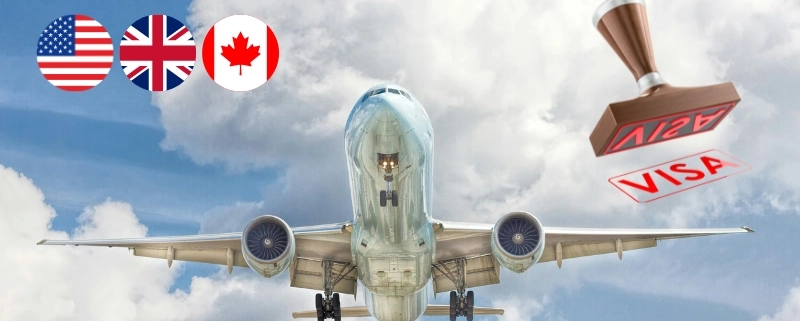Iran Visa for US, UK or Canadian Citizens
Traveling to Iran is both legal and possible for citizens of the United States, the United Kingdom, and Canada, although it involves a more detailed process than for other nationalities. For these travelers, it is highly recommended to begin the Iran visa application process at least two to three months in advance. This lead time is crucial due to additional vetting and the requirement for an Iranian-guided itinerary.
About Iran Visa for US, UK, or Canadian Citizens
Unlike travelers from many other nations, U.S., U.K., and Canadian passport holders cannot travel independently in Iran. Instead, they must book an organized tour or a private trip through a certified Iranian travel agency. This agency will assist in designing a full travel itinerary and applying for an authorization code from the Iranian Ministry of Foreign Affairs (MFA). This code is the first essential step in obtaining the visa.
Once issued, travelers can choose to collect their visa from a specified Iranian embassy or consulate, typically located in countries such as Turkey, the UAE, or, in some cases, directly by mail. While the rules may appear strict, they are simply formalities that help ensure a smooth and secure experience in Iran.
Applicants typically have three travel style options to choose from: a fully private and tailor-made tour that mirrors the flexibility of solo travel, a small group tour that balances personal space with reduced costs, or a large group tour that offers the most affordable rates and shared experiences with fellow travelers. Regardless of the format, all trips for U.S., U.K., and Canadian citizens must include a government-approved Iranian guide who accompanies the group throughout their journey.
This can be a practical option for travelers looking for a shorter, more spontaneous trip to Iran. Furthermore, upon arrival, most visitors, including U.S., U.K., and Canadian citizens, find the immigration process welcoming and respectful, as long as their documents are in order and they are not carrying a passport with an Israeli visa or stamp, which would lead to immediate denial of entry.
Iran Visa Types
Iran offers several types of visas depending on the nature of your travel. For most U.S., U.K., and Canadian citizens visiting Iran for tourism, the most relevant category is the Tourist Visa.
Other types include the Business Visa, Pilgrimage Visa, Student Visa, and Medical Visa, though these often require additional documentation and a more complex application process.
The Tourist Visa is valid for up to 30 days and can be extended once you’re in the country. The critical step remains obtaining an authorization code through an authorized Iranian travel agency, without which you cannot proceed. Once you have this code, you can submit your visa application to the embassy or consulate designated in your form.
The Iranian authorities strongly encourage that you do not book flights or make non-refundable payments before receiving your visa, although many travelers proceed with bookings after receiving their authorization code.
Required Documents
To apply for an Iranian visa, U.S., U.K., and Canadian citizens must submit the following documents: a valid passport (with at least six months of validity from the date of entry), a high-quality digital passport photo (meeting embassy specifications), a completed visa application form, and a detailed itinerary approved by a licensed Iranian tour operator.
Additionally, proof of travel insurance covering Iran is mandatory. Some embassies may also request a personal statement or letter of motivation. The travel agency usually helps prepare and submit the authorization request on your behalf.
Visa Price
As for costs, the Iran visa fee varies depending on your nationality and where you apply. U.S., U.K., and Canadian citizens typically pay toward the higher end of this spectrum.
An additional service fee charged by the Iranian travel agency for handling the authorization process is also common. It’s important to budget for both these costs when planning your trip.
Things to Consider
While Iran has strict rules, it is also known for its hospitality, safety, and vibrant culture. One essential regulation visitors must respect is the dress code: Women must wear a headscarf and modest clothing that covers the arms and legs, while men should avoid shorts and sleeveless shirts in public.
These rules apply from the moment you land until you depart. It’s also vital to understand that independent travel is not permitted for these three nationalities. However, this restriction doesn’t necessarily limit your experience—guided trips still offer deep, enriching access to Iran’s historical cities, desert landscapes, Persian architecture, and the warmth of its people.
Contrary to common perceptions, most foreign visitors—including Americans, British, and Canadians—find Iran to be a safe and welcoming country, often expressing surprise at how friendly locals are, especially when they learn where visitors come from.
Last Words
In conclusion, obtaining an Iran visa as a U.S., U.K., or Canadian citizen is entirely feasible, though it demands some advance planning, patience, and working closely with an Iranian travel agency. While the process involves extra steps, they are straightforward and designed to ensure a smooth experience. Iran’s breathtaking scenery, UNESCO World Heritage Sites, ancient cities, and welcoming locals make the effort well worth it. So, whether you’re drawn by the ruins of Persepolis, the poetry of Hafez in Shiraz, or the buzzing bazaars of Tehran, Iran awaits you with open arms and unforgettable stories. Just follow the guidelines, embrace the cultural differences, and prepare for a journey filled with richness and authenticity.
Are you planning to travel to Iran and looking for an Iran travel agency? Check out our Iran tours.








Leave a Reply
Want to join the discussion?Feel free to contribute!